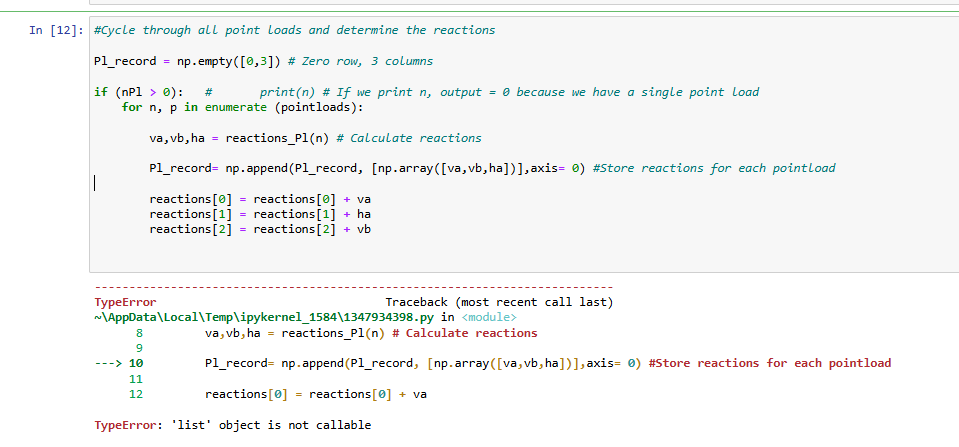Questions and discussion for this lecture live here. Fire away by hitting Reply below ![]()
Hey @fonkemfrank.cuib, have you downloaded the project code and compared your code with it?
S
I will try to write this project in C++ by looking at your videos. So far so good. Let’s see if I can finish. The only way to understand the code is to first draw it and solve it by hand then type in code. I am using point and a vector as one class object instead of splitting vectors into component variables.

#pragma once
#include <iostream> // For std::cout
#include <vector> // For std::vector
#include <array> // For std::array
#include "load_point.hpp" // For geo::LoadPoint
#include "load_line.hpp" // For geo::LoadLine
#include "moment_shear_and_bending.hpp"
std::array<geo::LoadPoint, 2> compute_reactions(const std::vector<geo::LoadPoint>& reactions, const geo::LoadPoint& point_load) {
double lever_arm_0 = reactions[0].p[0] - point_load.p[0];
double moment_0 = point_load.l[1] * lever_arm_0;
double lever_arm_1 = reactions[1].p[0] - reactions[0].p[0];
//result reactions
std::array<geo::LoadPoint, 2> reactions_temp = {{reactions[0], reactions[1]}};
reactions_temp[1].l[1] = moment_0 / lever_arm_1;
reactions_temp[0].l[1] = -point_load.l[1] - reactions_temp[1].l[1];
return reactions_temp;
}
void test_moment_shear_and_bending() {
// DIMENSIONS AND RESOLUTION
double span = 17;
int divisions = 10000;
// LOADS
std::vector<geo::LoadPoint> point_loads {{geo::Point(6, 0, 0), geo::Vector(0, -90, 0)}};
std::vector<geo::LoadPoint> point_moments {{geo::Point(17, 0, 0), geo::Vector(0, 0, 50)}};
std::vector<geo::LoadLine> distributed_loads {{geo::Line(8, 0, 0, 17, 0, 0), geo::Vector(-10, 0, 0), geo::Vector(0, 0, 0)}};
// REACTIONS
std::vector<geo::LoadPoint> reactions {
{geo::Point(3, 0, 0), geo::Vector(0, 0, 0)}, // Va and Ha
{geo::Point(13, 0, 0), geo::Vector(0, 0, 0)}, // Vb
};
// SHEAR AND BENDING MOMENT DIAGRAMSs
double distance_between_data_points = span / divisions;
std::vector<double> X;
X.reserve(divisions + 1);
for (double x = 0; x <= span; x += distance_between_data_points)
X.push_back(x);
std::vector<geo::LoadPoint> shear_force (divisions + 1);
std::vector<geo::LoadPoint> bending_moment (divisions + 1);
// COMPUTE REACTIONS
std::vector<std::array<geo::LoadPoint, 2> > reactions_record;
reactions_record.reserve(point_loads.size());
if (point_loads.size() > 0) {
for (size_t i = 0; i < point_loads.size(); i++) {
std::array<geo::LoadPoint, 2> temp_reactions = compute_reactions(reactions, point_loads[i]);
reactions_record.push_back(temp_reactions);
// Add reactions to record
reactions[0].l += temp_reactions[0].l;
reactions[1].l += temp_reactions[1].l;
}
}
// OUTPUT
std::cout << "Point loads:\n";
for (auto& pointload : point_loads)
std::cout << pointload << std::endl;
std::cout << "Reactions:\n";
for (auto& reaction : reactions)
std::cout << reaction << std::endl;
}
1 Like
